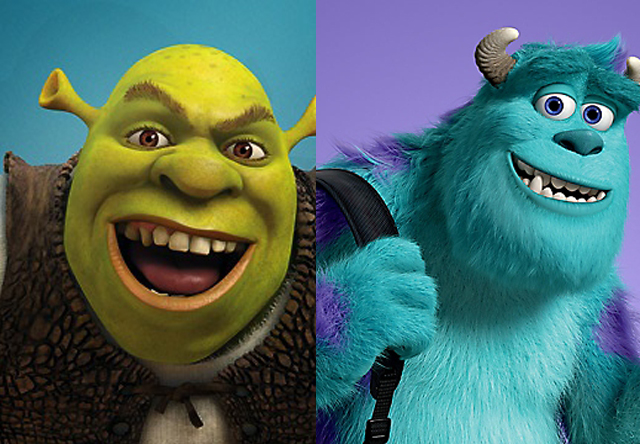
You would be hard pressed to find a career within the movie industry that has experienced the kinds of highs and lows of those that happened to Jeffrey Katzenberg. Once a rising star executive at two major studios, Katzenberg had a notorious falling out with one that led to his eventual and lucrative collaboration with some of Hollywood’s biggest players, creating a new landmark studio which he then left behind to pursue a new game-changing venture that ultimately became one of the biggest blunders in media history. The story of Katzenberg’s rises and falls are no doubt going to become the stuff of Hollywood legend, but there is no doubt that such tumultuous career could only belong to a creative executive who throughout his whole life has done nothing but bold steps. He first began his meteoric rise through the ranks at Paramount Pictures, where he managed to successfully revive the Star Trek franchise for the big screen. After that, he followed the then President of Paramount, Michael Eisner, to a new assignment at the Walt Disney Studios, where the latter was taking the reigns as the new CEO. Under Eisner’s watchful eye, Katzenberg was put in charge of the dwindling animation department; a field that Katzenberg knew nothing about. But, despite the lack of experience, Katzenberg oversaw a revival of animation at the studio with what is now known as the Disney Renaissance. However, his relationship with Eisner soured despite all the success, and he parted ways with Disney in a highly publicized feud that in many ways scared Katzenberg’s reputation in Hollywood. But, in a few months time, Katzenberg teamed up with two of the biggest names in showbiz, Steven Spielberg and David Geffen, to co-create what ultimately would be his most lasting legacy; Dreamworks Animation.
For Katzenberg, starting his own animation unit at Dreamworks was more than just a creative endeavor; it was also about besting Disney at their own game. This was readily apparent from the get go, as it became suspiciously convenient that both Disney and Dreamworks had computer animated movies with insects as characters being developed at the same time (1998’s Antz and A Bug’s Life). The same would apply for a number of other simultaneous releases within the same year, like two movies with a Latin American setting (Dreamworks’ The Road to El Dorado and Disney’s The Emperor’s New Groove) or two movies about aquatic wildlife (Dreamworks’ Shark Tale and Disney’s Finding Nemo). Because the movies were so close together, you couldn’t say one was copying the other due to the lengthy production periods that animated movies need to be completed, and there were enough different elements in each one to dispel any complaints of plagiarism. But, even still, there was a definite strategy behind Dreamworks’ direct challenges to the powerhouse that was Disney. And the reason why it worried Disney was because Dreamworks was successful at it. Katzenberg not only was redefining the animated movie over at Dreamworks, with it’s more edgy style, he was also getting the mainstream audiences to jump on board as well. The PG-rated The Prince of Egypt (1998) became the first non-Disney animated film to cross the $100 million mark at the box office, and Antz‘s more adult humor became much more of a hit with the critical community than the “safe” family friendly A Bug’s Life. But one of the most crucial head to head battles occurred twenty years ago, in the year 2001, when Dreamworks delivered it’s first true mega hit, Shrek, into theaters, with Disney and their animation partner Pixar delivering another film centered around a monster protagonist called Monsters Inc. only a few months after. The head to head battle at the time certainly favored Dreamworks, and it also sparked a rivalry with the two studios that would come to dominate the following decade. But in the years since, does Shrek still come out on top of Monsters, or did the long game work in the latter’s favor. More than anything, this rivalry certainly reveals an interesting window into what drove the future of animation into the new millennium.
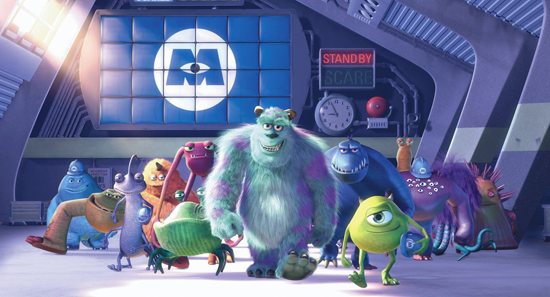
“Monsters Incorporated. We scare, because we care.”
Animation was in a state of flux at the time that Shrek and Monsters Inc. made their way into theaters. The hand drawn style that Jeffrey Katzenberg had helped bring back from the dead and dominated the decade prior, was again falling behind, thanks in no small part to the rise of computer animation. The double blow of these two movies in the same year no doubt was one of final death blows to traditional animation, especially after Disney’s own Atlantis: The Lost Empire (2001) crashed and burned that same Summer. Dreamworks’ rise came at an opportune time, as Disney was itself struggling once again, and were relying upon Pixar to keep their reputation afloat. Though Dreamworks’ rivalry was geared to target Disney directly, Pixar would end up being the most effective weapon for the studio for a time, and that in itself was a tenuous alliance. Pixar was looking to break free once their contract was up after the movie Cars (2006), which would’ve put Disney in a precarious position if they had to face off against two rivals instead of one. More than anything, the inability to deal with the competition from Dreamworks and the rocky relationship with Pixar is what led to an abrupt end to Michael Eisner’s reign at the head of Disney, and ultimately to Bob Iger who’s first order of business was to finally buy out Pixar completely and make it an official part of the company. All the while, Pixar continued to build on every movie they made, and push animation further. Monsters Inc. was an especially important moment for the studio, as it was the first film to be directed by someone other than Pixar founder John Lasseter. In the director’s chair this time was Pete Doctor, who would go on to direct classics like Up (2009), Inside Out (2015) and the recent Soul (2020), while also ascending to the Creative Director of Pixar role after Lasseter’s departure. While continuing the studio’s high standard of animation, Monsters Inc. would also help to define the thing that would help Pixar to differentiate itself from competitors like Dreamworks the most; it’s heartfelt devotion to story.
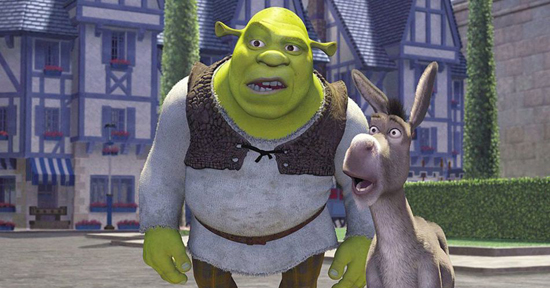
“We can stay up late, swapping manly stories, and in the morning, I’m making waffles!”
Comparing the two movies, there is one thing that is clearly apparent between the two, and that is it’s sense of humor. They are both very funny movies, but there is a clear distinction behind the target of the comedy. Shrek is first and foremost a satire; specifically with an intent to mock the Walt Disney Company. Though based on a children’s book by William Steig, Shrek becomes over the course of the film a deconstruction of fairy tale tropes and characters, with the titular ogre often being the one dolling out the sarcastic commentary that drives home the absurdity of the world he lives in. By contrast, Monsters Inc.‘s comedy is more situational and character driven. Sure, there are satirical elements thrown about with the way that the world of the monsters is constructed to reflect our own, but it’s largely in the background, with the humor being derived more from character interactions. Shrek also has that, but it’s very apparent that Katzenberg wants to bring more attention to the satirical bits that particularly take shots at his old employer. This is evident in the scene when Shrek and his companion Donkey enter the kingdom of Dulac, home of the villainous Lord Farquad. Dulac is clearly based on the faux fairy tale aesthetic of a Disney theme park, where everything is clean and orderly. A bit of this scene does get a little mean-spirited, especially with the “It’s a Small World” parody song, though I will admit the scene where a frightened Dulac citizen runs away from Shrek while still staying within the roped queue line is still pretty hilarious and on point. There are no sharply satiric gags in Monsters Inc., as it takes it’s jabs at the soullessness of corporate culture a bit more seriously, but at the same time, I would say it is still a very funny movie. The big difference between the comedy of the two movies could easily be summed up as Monsters is more Laurel and Hardy while Shrek is more Marx Brothers, considering where each individual movie targets it’s funniest moments.
The characters themselves are also an interesting dichotomy of where the movies differ. The protagonists themselves are presented in interestingly different ways. Shrek (voiced by Mike Myers) begins his story as an outsider, content on his solitude and deeply cynical towards the idea of fairy tale endings. James P. Sullivan, or Sully for short (voiced by John Goodman) is a monster on top of his game and a strong believer in the status quo system. But, over the course of the story, Shrek begins to let go of his cynical edge and opens up to allow more people into his life, namely the wisecracking Donkey (voiced by Eddie Murphy) and the enchanting Princess Fiona (voiced by Cameron Diaz). The growth of Shrek’s character finds a nice parable within movie itself through the metaphor of onions and their layers. Sully’s journey comes less from a growth and more of a sacrifice, and he finds his notion of content life shaken once he encounters a little human girl he names Boo. In the monster world, human children are considered toxic and radioactive, so Sully has been taught to avoid contact, except when he’s harvesting screams for energy production. Once he meets Boo, he learns that all the precautions he was taught to uphold were made off of false information, it shakes his belief in the system that has defined his whole life. Both Shrek and Sully make fundamental changes, but they both start and end in different places. Shrek is softened while Sully is hardened. At the same time, it doesn’t change their characters entirely; Shrek remains a grouchy ogre through it all, but now he is able to let others into his world, while Sully remains a kind monster at heart, but less gullible and more determined to set things right even at his own expense. What both movies get right is in showing how their adventures shape the person that they are destined to be, or in a more metaphoric sense, peeling away the layers of the onion. Part of the reason why both movies resonated so well with audiences is that both Shrek and Sully work as engaging and lovable heroes that we the audience immediately grow attached to.
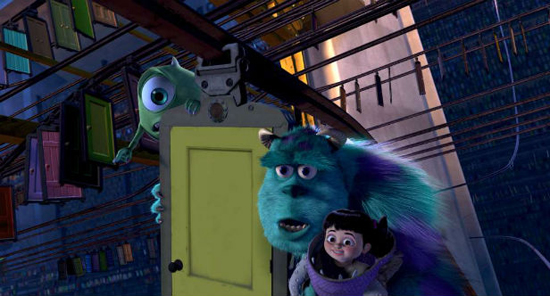
“Twenty-three nineteen. We have a Twenty-three nineteen!!”
One thing that is also comparable about the two movies is that much of the stories center on the protagonist’s relationship with their comedic foil. Shrek and Sully are largely the straightmen to their zanier counterparts, Donkey and Mike Wazowski (voiced by Billy Crystal). The chemistry between the characters in their selective films are similar but the resulting level of laughs can differ. Don’t get me wrong, Billy Crystal is very funny in the role of Mike Wazowski, but it’s something that doesn’t feel too out of character for him either, even as he’s playing a one-eyeballed creature. Eddie Murphy on the other hand delivers a stand-out comedic performance as Donkey, and humor resonates a little more because it does feel more out of place in the grand scheme of the movie. It’s Eddie Murphy, delivering his usual high energy zaniness, but done through the body of a talking donkey, which makes the character even more hilariously unpredictable. In a way, I feel that Eddie Murphy is having to pull a lot more weight with his role and making it his own, while Billy Crystal is doing his part but not in a particularly ground-breaking way. Mike Wazowski is a sidekick character that we are largely already familiar with, while Donkey is not, and that helps to give Shrek a little bit of an edge. Where Monsters manages to counter that edge is in the role of the antagonist. In the movie Shrek, Lord Farquad is as stock of a villain as you could’ve expected (though still voiced well by John Lithgow). In many ways, he exists more as another pointed jab at Katzenberg’s former boss Michael Eisner, as they share similar jawlines; though Farquad’s short stature is a closer resemblance to Katzenberg’s own height, so I guess it’s him taking a bit of his own medicine too. In contrast, Monsters Inc.‘s Randall Boggs (voiced by Steve Buscemi) is a far more menacing rival, with a motivation that’s far more sinister. Given the childish motivations of Farquad’s plans (marrying Princess Fiona against her wishes) and the insidiousness of Randall’s plans (kidnapping children for cheap energy extraction), the stakes just feel a bit higher in Monsters Inc. as a whole, and as a result the story resonates a bit stronger.
There is a lot to say about the character, humor, and plotting to separate the effectiveness of the two films, but what about the level of animation. In a way, I think that Shrek actually succeeds a little better at world building, as it broke a lot of new ground at the time with regards to environmental animation. There is a lot of variety in the locations found throughout Shrek; from the ogre’s swamp, to the sanitized (and phallic) Dulac, to the lushness of the Enchanted Woods, to the imaginative Castle on top of a volcano. By contrast, Monsters Inc. doesn’t quite take advantage of it’s locals. We only get the smallest sampling of the larger world of the monsters, and how their society is modified to accommodate creatures of all shapes and sizes. The majority of the movie is set solely within the confines of the Monsters Inc. facility itself, which kind of minimizes our view of the world at large itself. It’s like the movie holds back from an even grander tale by just limiting everything to a single location. The movie does expand out towards the end, once Sulley, Mike and Boo travel into the expansive and mind-blowing Door Vault at Monsters Inc. But where they saved the big showpiece for the end, Shrek delivers through the whole movie, and delivers a rich bit of variety throughout. But, as good as the environments are in Shrek, the character animation leaves much to be desired. For some reason, Dreamworks believed in recreating as much photo-realism with the human characters as they could, which sadly dips into the uncanny valley region, especially with Princess Fiona. With Shrek being the most caricatured character, he fares a bit better, but let’s just say the years haven’t been kind to all the other character models in Shrek. Monsters Inc. on the other hand features incredible character animation that stays true to the cartoonish look that Pixar has always strived for. The fur on Sully was especially ground-breaking for it’s time, and set the standard for rendering realistic looking hair and fur for computer animation in the years after. Shrek proved through it’s own mistake that animation should adhere to stylized character models, and thankfully Dreamworks has moved more in that direction over the years, especially with their human characters. Both movies certainly broke new ground in computer animation in their own way, but I feel that Monsters Inc. is the one that holds up better over time given all the advances that have been made since.
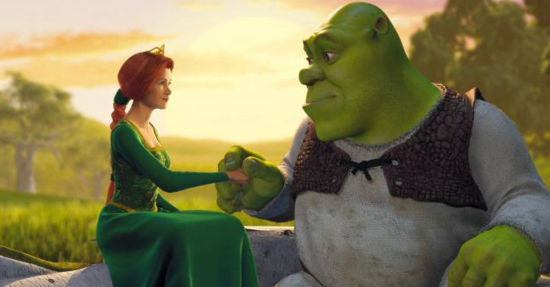
“Oh, you were expecting Prince Charming?”
There’s no doubt that after all is said and done, the the most lasting thing that Jeffrey Katzenberg will leave behind in Hollywood is the legacy of Shrek and it’s influence in turning Dreamworks into a powerhouse in animation. It’s probably even enough to overcome the embarrassing failure of Katzenberg’s most recent creative endeavor, Quibi, which turned into a $2 billion catastrophe that couldn’t even take off in the middle of a streaming boom. Though Katzenberg has long moved on from the animation giant that he helped to build, his influence can still be felt there, and that’s largely due to the standard that was set by Shrek. Dreamworks Animation is defined by it’s hard edges, and willingness to be a little irreverent towards old Hollywood tropes. Shrek no doubt is the best version of this mission statement, but I can’t help but feel that the edge has been dulled over time. One thing that hasn’t helped out Shrek much is the over-abundance of sequels and spin-offs that have stemmed from it. In a way, Shrek being as highly marketable as it was, became the very thing that the original film was mocking in the first place; a soulless corporate cash cow. In the meantime, Monsters Inc. grew in stature and still is fondly remembered to this day. It didn’t even entertain the idea of a sequel until after Shrek had made three already, releasing Monsters University (2013), a full 12 year later. Monsters’ other long legacy, no doubt helped by director Pete Doctor, was in continuing the importance of emotional story-telling. The film’s closing moment, where Sully reunites with Boo, is a moment that will warm anyone’s heart, and its something that Pixar continues to strive for with every new film thereafter. I think that’s the ultimate result of the contentious rivalry between Dreamworks and Disney/Pixar; while Dreamworks can launch movies off like a rocket, Disney and Pixar make movies that burn long into the night. Shrek is a ground-breaking movie, and one that still has entertainment value, but I think is most potent element is sadly tied up in the past, when it was more in vogue to knock Disney down a few pegs. In the years since, it has proven much more effective to be a timeless, evergreen story rather than a sharp-tongued satire forever anchored to a specific moment in time. And that is why Monsters Inc. continues to remain a perennial classic, while Shrek is looking more and more like a relic.
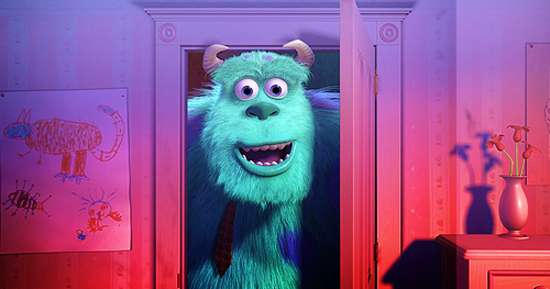
“Kitty!!!”